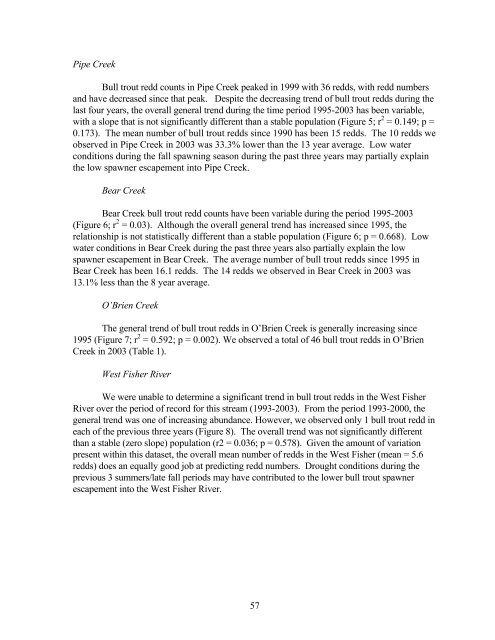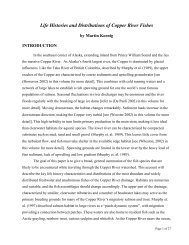Mitigation for the Construction and Operation of Libby Dam
Mitigation for the Construction and Operation of Libby Dam
Mitigation for the Construction and Operation of Libby Dam
Create successful ePaper yourself
Turn your PDF publications into a flip-book with our unique Google optimized e-Paper software.
Pipe Creek<br />
Bull trout redd counts in Pipe Creek peaked in 1999 with 36 redds, with redd numbers<br />
<strong>and</strong> have decreased since that peak. Despite <strong>the</strong> decreasing trend <strong>of</strong> bull trout redds during <strong>the</strong><br />
last four years, <strong>the</strong> overall general trend during <strong>the</strong> time period 1995-2003 has been variable,<br />
with a slope that is not significantly different than a stable population (Figure 5; r 2 = 0.149; p =<br />
0.173). The mean number <strong>of</strong> bull trout redds since 1990 has been 15 redds. The 10 redds we<br />
observed in Pipe Creek in 2003 was 33.3% lower than <strong>the</strong> 13 year average. Low water<br />
conditions during <strong>the</strong> fall spawning season during <strong>the</strong> past three years may partially explain<br />
<strong>the</strong> low spawner escapement into Pipe Creek.<br />
Bear Creek<br />
Bear Creek bull trout redd counts have been variable during <strong>the</strong> period 1995-2003<br />
(Figure 6; r 2 = 0.03). Although <strong>the</strong> overall general trend has increased since 1995, <strong>the</strong><br />
relationship is not statistically different than a stable population (Figure 6; p = 0.668). Low<br />
water conditions in Bear Creek during <strong>the</strong> past three years also partially explain <strong>the</strong> low<br />
spawner escapement in Bear Creek. The average number <strong>of</strong> bull trout redds since 1995 in<br />
Bear Creek has been 16.1 redds. The 14 redds we observed in Bear Creek in 2003 was<br />
13.1% less than <strong>the</strong> 8 year average.<br />
O’Brien Creek<br />
The general trend <strong>of</strong> bull trout redds in O’Brien Creek is generally increasing since<br />
1995 (Figure 7; r 2 = 0.592; p = 0.002). We observed a total <strong>of</strong> 46 bull trout redds in O’Brien<br />
Creek in 2003 (Table 1).<br />
West Fisher River<br />
We were unable to determine a significant trend in bull trout redds in <strong>the</strong> West Fisher<br />
River over <strong>the</strong> period <strong>of</strong> record <strong>for</strong> this stream (1993-2003). From <strong>the</strong> period 1993-2000, <strong>the</strong><br />
general trend was one <strong>of</strong> increasing abundance. However, we observed only 1 bull trout redd in<br />
each <strong>of</strong> <strong>the</strong> previous three years (Figure 8). The overall trend was not significantly different<br />
than a stable (zero slope) population (r2 = 0.036; p = 0.578). Given <strong>the</strong> amount <strong>of</strong> variation<br />
present within this dataset, <strong>the</strong> overall mean number <strong>of</strong> redds in <strong>the</strong> West Fisher (mean = 5.6<br />
redds) does an equally good job at predicting redd numbers. Drought conditions during <strong>the</strong><br />
previous 3 summers/late fall periods may have contributed to <strong>the</strong> lower bull trout spawner<br />
escapement into <strong>the</strong> West Fisher River.<br />
57
















